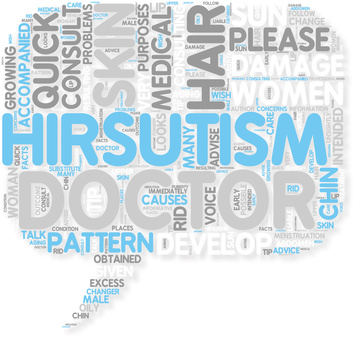HIRSUTISM.
Too much of the ‘wrong sort’ of hair ‘in the wrong places’.
What is Hirsutism?
Hirsutism is excessive androgen-dependent Hair Growth in women. Androgen-dependent hair is the thicker, pigmented hair normally found in areas such as the pubic area or under the arms.
The androgen-dependent hair of hirsutism tends to start in the following parts of the body:
- Upper lip
- Chin
- Middle of the upper chest
- Above the belly button
- Above the pubic area
- Between the Shoulder Blades
- Lower Back
- Upper Inner thighs
- Upper Arms
What are the causes of Hirsutism?
- Polycystic Ovarian Syndrome (PCOS) accounts for around 72%
- Idiopathic (Hirsutism on its own without any underlying medical cause) accounts for around 23%
- Non-classical adrenal hyperplasia (CAH) is less common
- Androgen secreting tumours are very rare – consider when hirsutism is severe or develops rapidly outside of adolescence/early adulthood (a time when idiopathic hirsutism and PCOS are more likely to develop)
Usually Hirsutism is either idiopathic or caused by PCOS. Idiopathic Hirsutism reflects a sensitivity of the androgen-sensitive areas to testosterone (The blood testosterone levels are normal).
Non medical and medical treatments for hirsutism are similar for all the common causes including CAH.
PCOS may be linked to health issues other than hirtsutism – for example risk of diabetes, high Blood Pressure and/or fertility issues when the periods are infrequent, irregular or absent. So a diagnosis of PCOS (as opposed to idiopathic hirsutism) is generally worth making even if the hirsutism treatments are basically the same.
Usually Hirsutism is either caused by PCOS, or is idiopathic.
What tests might be worth getting done?
A woman with a very low likelihood of an underlying cause probably does not need any tests doing at all – for example, mild hirsutism with a normal menstrual cycle and no features of PCOS or any endocrine disorder.
When an underlying cause is thought more likely then the following blood tests may be considered
- Thyroid Function Blood Test (though usually associated with dry and coarse hair rather than hirsutism)
- Prolactin (optional test)
- Testosterone and sex hormone binding globulin (SHBG)
- 17-hydroxyprogesterone may be considered if a diagnosis of non classical CAH is thought important
The key blood test (if any are done) is the testosterone and SHBG. The SHBG is a protein that carries testosterone in the blood whereas the free testosterone is not bound to any protein. PCOS (& obesity) pushes down the SHBG so that there may be a raised free (but not total) testosterone level.
PCOS is present when at least 2 of the following 3 present:
- Infrequent (at least 35 days between the start of each menstrual cycle) or absent periods
- Symptoms of excessive Androgens (Hirsutism, acne, Alopecia caused by XS androgens) OR a high blood free testosterone level
- Polycystic Ovaries on ultrasound
A pelvic ultrasound may therefore be requested to help diagnose PCOS. PCOS may be diagnosed without an ultrasound (the first two of the features above is sufficient to make the diagnosis). It’s worth noting that polycystic ovaries are very common without any features of PCOS. Around a quarter of women have polycystic ovaries on an ultrasound – but only a proportion have PCOS.
All the tests are normal with idiopathic Hirsutism.
What are the Hirsutism non-medication treatments?
Options for non-medical treatment are:
- Depilatory Creams
- Waxing
- Shaving
- Electrolysis: treats a smaller area than laser treatment but is suitable for a wide range of hair and skin types
- Laser treatment: treats a wider area of skin than electrolysis. However, it’s less effective in darker skin or lighter hair
Weight loss in obesity may also beneficial – particularly with PCOS.
Is there a Cream for Hirsutism?
Eflornithine is a topical prescription-only cream that reduces matrix cell proliferation in hair follicles. It is licensed for use only on the face. A trial showed around a quarter reduction in facial hair after 6 months, with most benefit seen after 2 months. It can be combined with oral medication & laser therapy.
What tablets are there for Hirsutism?
There is a role for tablets in the treatment of more troublesome hirsutism.
The following medication may be prescribed in a rough pecking order of most commonly to least commonly prescribed:
- Combined Oral Contraceptive Pill (COP) – the anti-androgenic pills such as the brands Yasmin or Dianette are well known
- Cyproterone – a low dose of this is already in Dianette but a higher dose of cyproterone may be separately prescribed for the first 10 days of each calendar pack of the oral contraceptive
- Spironolactone – this is about as effective as Cyproterone
- Metformin
- Finasteride
- Flutamide is also an option though the risk of liver toxicity suggest it’s best prescribed in only limited circumstances
A common issue is that the COP should not be prescribed in a woman who is at higher risk of venous thrombosis – for example, a BMI > 35.
For women with a BMI >35 who should not be on the combined oral contraceptive pill (with or without cyproterone), Spironolactone is a useful option. Spironolactone tends to cause some menstrual irregularity. There should be effective contraception for use of spironolactone, finasteride and flutamide because of the risk of fetal damage.
For women with a BMI >35 who should not be on the combined oral contraceptive pill (with or without cyproterone), Spironolactone is a useful option.





Please Telephone us (not email) with any enquiries.